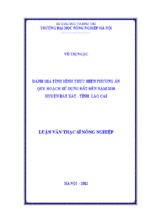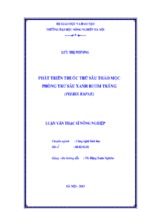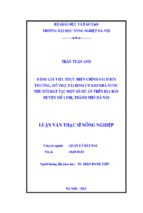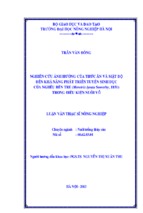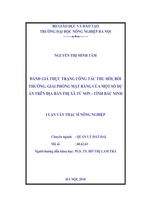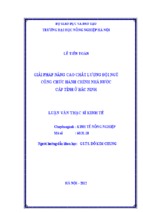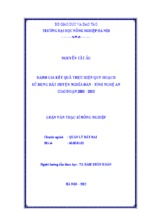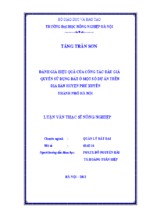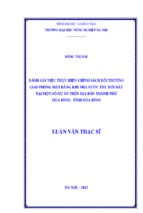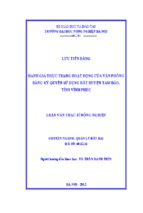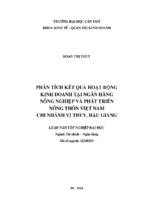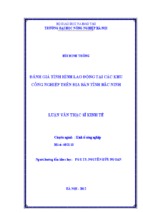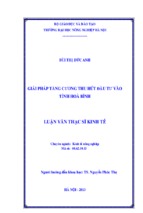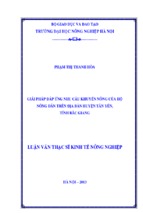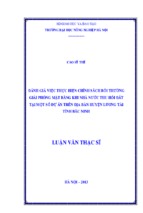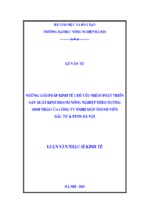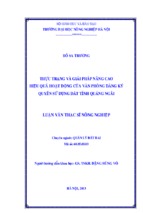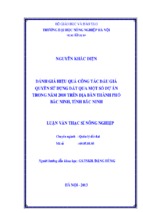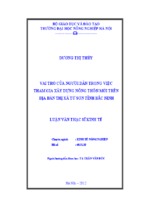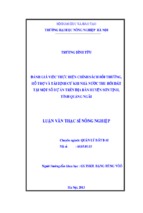THAI NGUYEN UNIVERSITY
SCHOOL OF FOREIGN LANGUAGES
LE THI NGA
A STUDY ON HA LONG GIFTED HIGH SCHOOL ENGLISH
TEACHERS’ ADDRESSING OF INTERCULTURAL ASPECTS
IN THEIR CLASSES
(Nghiên cứu về việc xử lý các khía cạnh liên văn hóa trong lớp học
tiếng Anh của giáo viên ở Trường Chuyên Hạ Long)
M.A. THESIS
Field: English Linguistics
Code: 8220201
THAI NGUYEN – 2019
3
ATTESTATION OF AUTHORSHIP
I hereby declare that this submission of the minor thesis entitled “ A study on
Ha Long gifted high school English teachers’ addressing of intercultural aspects
in their classes” is my own work. To the best of my knowledge, it contains no
materials previously published or written by another person, or substantial
proportions of material which have been accepted for the award of any other degree
or diploma at SFL or any other educational institutions. The thesis has not been
submitted to any other examining body and has not been published. Any contribution
made to the research by others is explicitly acknowledged in the thesis.
Thai Nguyen, July 2019
Le Thi Nga
Approved by
SUPERVISOR
Dr. Nguyen Thi Hang
i
4
ACKNOWLEDGEMENT
This thesis could not have been accomplished without the help and support from
a number of people.
First and foremost, I would like to express my sincere thanks and my deepest
gratitude towards Dr. Nguyen Thi Hang, my supervisor, for her thorough instruction,
precious guidance and ideas and constant encouragement from the first day of working
out the outline for the research to the last days of writing up the thesis. Without her
invaluable support, this graduation paper would not have been completed.
My special thanks are also sent to my colleagues and my beloved students at Ha
Long high school for gifted students for their enthusiastic participation in my study.
Their devoted and sincere contribution helped shape the validity and reliability of this
study.
Last but not least, I owe a great debt of gratitude towards my family and my
friends for their endless care, support and faith in me.
Thai Nguyen, July 2019
Le Thi Nga
ii
5
ABSTRACT
This study examines the practice of teaching culture among English teachers at
high school in Vietnam with practical experience in English as a foreign language. It
focuses on the forms of intercultural learning provided by teachers and teachers’ utility
of culture input to develop students’ intercultural competence.
Teachers of English at Ha Long high school for gifted students are considered a
cultural group, which is the reason for me to apply an ethnographic method in the study.
The data for analysis is collected from two sources: class observations and postobservation interviews with the teacher participants.
The findings show that culture teaching is now integrated closely with linguistic
competence in the curriculum. The teachers exploit different forms of intercultural
learning to provide students with intercultural knowledge, among which project-based
learning activity, discussion on cultural differences and role plays are of extreme
preference, enabling students to self-discover the culture aspects assigned. Noticeably,
most of those forms are based on the input available in the set English textbook. Teachers
had little opportunity to use supplementary material. In the practice of culture teaching,
the factors preventing both students and teachers from achieving their culture-intaking
were also explained, among which time constraint was the key reason.
Based on the findings of the study, recommendations are provided for both
English teachers and educational administrator for improving the quality and quantity of
culture teaching at high schools in Vietnam.
iii
6
TABLE OF CONTENT
CHAPTER 1. INTRODUCTION ................................................................................. 1
1.1. Introduction ............................................................................................................... 1
1.2. Rationale ................................................................................................................... 2
1.3. Aims of the study ...................................................................................................... 4
1.4. Research questions .................................................................................................... 4
1.5. Significance of the study ........................................................................................... 4
1.6. Scope of the study ..................................................................................................... 5
1.7. Design of the study.................................................................................................... 5
CHAPTER 2. LITERATURE REVIEW ..................................................................... 6
2.1. Conceptualisations of culture .................................................................................... 6
2.2. Culture in language education ................................................................................... 7
2.2.1. Relationship between language and culture .......................................................... 7
2.2.2. Intercultural competence ....................................................................................... 8
2.3. Cultural content in language teaching materials ....................................................... 9
2.4. Previous studies of IC teaching ............................................................................... 10
CHAPTER 3. METHODOLOGY .............................................................................. 13
3.1. Ethnography ............................................................................................................ 13
3.2. Field site and participants........................................................................................ 14
3.3. Data collection procedure ....................................................................................... 16
3.3.1. Classroom observation......................................................................................... 16
3.3.2. Semi-structured interviews ................................................................................... 17
3. 4. Data analysis .......................................................................................................... 19
3.4.1. Step 1 .................................................................................................................... 19
3.4.2. Step 2 .................................................................................................................... 20
3.4.3. Step 3 .................................................................................................................... 20
iv
7
CHAPTER 4. FINDINGS AND DISCUSSION ........................................................ 21
4.1. Forms of intercultural learning provided by the teachers ....................................... 21
4.1.1. Project-based learning ......................................................................................... 22
4.1.2. Discussion on cultural differences ....................................................................... 25
4.1.3. Role-play .............................................................................................................. 27
4.2. Teachers’ utility of culture input to develop students’ intercultural competence........ 30
4.2.1. Teachers’ use of set teaching materials ............................................................... 31
4.2.2. Teachers’ use of supplementary culture input ..................................................... 36
4.3. Summary ................................................................................................................. 40
CHAPTER V. CONCLUSION ................................................................................... 41
5.1. Summary of the findings ......................................................................................... 41
5.1.1 Forms of intercultural learning provided by the teachers .................................... 41
5.1.2. Teacher’s utility of culture input .......................................................................... 42
5.2. Recommendations for more effective integration of culture into English lessons... ..42
5.2.1. Physical dimension............................................................................................... 42
5.2.2. Professional dimension ........................................................................................ 43
5.2.3. Providing teachers with more professional support ............................................ 43
5.3. Limitations of the study .......................................................................................... 44
5.4. Suggestions for further study .................................................................................. 44
5.5. Conclusion............................................................................................................... 45
REFERENCES ............................................................................................................. 46
APPENDICES ................................................................................................................ I
APPENDIX 1: CLASS OBSERVATION SHEET .......................................................... I
APPENDIX 2: THE INTERVIEW GUIDE ................................................................... II
v8
LIST OF ABBREVIATIONS
EFL: English as a foreign language
IC: Intercultural competence
ICC: Intercultural communicative competence
MOET: Ministry of Education and Training
vi
9
LIST OF TABLES`
Table 3.1: Demographic information about participants …………………………… 16
Table 4. 1: Summary of intercultural learning forms……………………..…............. 22
Table 4. 2: Summary of project-based learning activities………………...…………. 23
Table 4. 3: Summary of discussion activities……………………………...………… 27
Table 4. 4: Summary of role-play activities……………………..…………………... 29
Table 4. 5: Summary of how culture input utilized…………………...……………... 32
Table 4. 6: Culture input provided in set teaching materials………………...………. 36
vii
10
CHAPTER 1. INTRODUCTION
1.1. Introduction
In the age of globalization with its resulting economic, technological, social and
educational transformation, there is an increased need for the development of
intercultural competence (IC). This ability to communicate across cultural boundaries
and mediate between cultures should be an important goal of language education
(Byram, 1997, 2009). In order to develop learners’ IC, culture is regarded a core
element and strongly linked with language. In this sense, culture plays a critically
important part in language teaching which is acknowledged by the English teaching
circle (Wang, 2011). Language is both a part of culture and at the same time the deepest
cultural reflection. The linguist Robert Lado defines the goal of learning a foreign
language as “the ability to use it, understanding its meanings and connotations in terms
of the target language and culture, and the ability to understand the speech and writing
of natives of the target culture in terms of their great ideas and achievement” (Lado,
1964). Therefore, the English teaching inevitably involves culture teaching.
In Vietnam, the traditional perspective that teaching the language simply means
providing students with an understanding of the nature of the foreign language, asking
the student to do lexical and grammatical exercises or developing one or two language
skills such as reading or writing has become out of date. Hoang (2016) stated that the
purpose of learning the language in modern time is using language elements like
pronunciation, vocabulary, and grammar and four language skills to reach the target of
developing students’ intercultural competence (IC). This enables students to
understand foreigners and communicate with them in real life.
From Hoang’ perspectives, to address IC, which is a new focus of English
curriculum, culture must be explicitly taught as a central element and integrated with
the teaching of language (Crozet & Liddicoat, 1999, 2000; Liddicoat, 2002; Newton
& Shearn, 2010b). In fact, the IC objectives have been highlighted by the Ministry of
Education and Training (MOET) when compiling new English teaching syllabus. The
introduction of a newly added section - Communication and Culture- is a good example
1
of overt intercultural integration of the new English textbooks. It is confirmed that the
integration of culture into EFL teaching in Vietnam has been recognized from macro
level with the evidence of IC objectives in the curriculum and the representation of
intercultural contents and activities in the new English textbooks. However, to enact
this reformation comprehensively, EFL teachers should take active roles as the main
implementers, who integrate culture into their teaching appropriately to their students
and teaching contexts.
The widespread of this modern approach has led to some positive changes in
foreign language education in Vietnam. One noticeable change is the teachers’ positive
attitudes towards culture teaching. Interestingly, more and more high schoolteachers
in foreign language education have realized they need to devote more efforts so as to
facilitate language learners to develop their intercultural communication competence,
(Zhang, 2017). Gifted high school teachers who are in charge of training brilliant
students should be pioneers in integrating culture into the teaching and learning of
foreign language for the development of learners’ IC.
However, it is a fact that there is still a heavy focus on only linguistic knowledge,
while culture has not received enough attention and devotion as observed by Ho
(2011), as well as in my own experience. This is also the case in Ha Long high school
for gifted students where I am currently teaching. Regarding the need to investigate
culture teaching in the context of foreign language teaching at high school, the study
explores the relevance of implementing the cultural aspects of Ha Long high gifted
schoolteachers in the teaching and learning English.
1.2. Rationale
There are three main reasons why I conducted this present study.
Firstly, I carried out this study based on my great passion for cultural aspects in
language education and my awareness about the importance of integrating culture into
language teaching for the development of language learners’ IC. It was the most
important driving force that motivated me to engage in conducting this study. From
the findings of the study, I can gain insights into the realities of teaching and learning
2
culture in a gifted high school where I am working. The findings were expected to
broaden my professional knowledge about the culture teaching practices so that I can
apply it into my own teaching for better learning outcomes for my students in terms of
developing their ability to communicate across cultures in intercultural settings.
Secondly, in the Vietnamese context of foreign language education, there is
superficial knowledge about the issue of addressing IC. There have been limited
numbers of studies thoroughly investigating Vietnamese language teachers’ beliefs and
practices in integrating culture in their language teaching, except for Nguyen (2013)
study. His study extensively or comprehensively examines how EFL teachers in a
Vietnamese university EFL teaching context address culture. However, as a high
school teacher, I would like to investigate this issue in a high gifted school where I am
currently teaching to become more aware of my colleagues’ teaching practices, which
is useful for my professional development.
Thirdly, the study aimed at offering recommendations for making positive change
in foreign language education in Vietnam, particularly at the high school level of
education. This critical element will help language teachers as well as my colleagues
at my school to make changes in their teaching practices. These changes might include
more supportive policies produced by foreign language education policy makers,
teachers’ awareness of the important role of culture in language teaching, teachers’
pedagogical learning and knowledge, teachers’ own IC, and teachers’ ability to teach
and assess IC. Such changes, when made in the Vietnamese teachers’ language
education context, will ultimately enable learners develop their ability to communicate
across cultures in intercultural situations, thus meeting the requirements of the new
government foreign language education policy.
As a teacher of English at Ha Long high school for gifted students, who is aware
of the fact and wish to contribute some suggestions for possible improvements in
learners’ IC, I decided to do the research entitled “a study on Ha Long gifted high
school English teachers’ addressing of intercultural aspects in their classes.”
1.3. Aims of the study
3
This study is aimed at exploring how the teachers of English at Ha Long high
school for gifted students address cultural aspects in their classes in terms of the intercultural learning opportunities they provided, and the culture input they utilized.
Moreover, the study is also targeted at examining some obstacles facing the teacher
participants whilst teaching culture to propose practical pedagogical solutions.
1.4. Research questions
Based on the aims set up above, the study addresses the following research
questions:
1. What forms of inter-cultural learning do gifted high school teachers of English
provide for their students?
2. How do gifted high school teachers of English utilize culture input to develop
their students’ intercultural competence?
1.5. Significance of the study
The study is expected to raise language teachers’ awareness of the cultural
components in EFL teaching and learning for the development of learners’ IC. From
the findings of this study, some pedagogical recommendations will be provided to help
EFL teachers address cultural aspects in their classroom more effectively.
Moreover, I would like to share my understanding about this interesting and
useful issue with my colleagues who have the same enjoyment of teaching English in
different cultures.
1.6. Scope of the study
The study was carried out with the participation of five teachers of English
teaching 12th grade students at Ha Long high school for gifted students in the academic
year 2018-2019.
The study focuses on the reality of teaching and learning English at Ha Long high
school for gifted students. It centers on the teachers’ provision of culture learning
opportunities for the students, especially teachers’ explanation of cultural components,
teachers’ setting and managing of tasks and activities that foster students’ culture
learning, teachers’ use of teaching materials and other teaching aids.
4
1.7. Design of the study
The study consists of five chapters as follows:
Chapter I: Introduction: This chapter includes the rationale of the study, the aims
and scope of the study as well as the research questions.
Chapter II: Literature review: This chapter presents some key definitions related
to IC and a review of previous studies conducted by both foreign and domestic
researchers to give the whole picture of the matter.
Chapter III: Methodology: This chapter describes my methodology including
research method, field sites and participants, data collection instruments, data
collection procedure and data analysis.
Chapter IV: Data analysis and discussion: This chapter analyses and discusses
the data obtained from classroom observation and post-observation interviews.
Chapter V: Conclusion: The final chapter summarizes the key findings of the
study, puts forward some recommendations based on these findings and gives
suggestions for further study and the limitations of this thesis.
5
CHAPTER 2. LITERATURE REVIEW
Culture and teaching culture in a language class have been of great attention from
language researchers and teachers. Culture has been viewed from various perspectives.
In order to provide the basic theoretical framework for the study, this chapter begins
with a review of culture in general. The next part gets closer to culture in language
teaching, followed by an overview of culture teaching practices. This chapter ends with
a review of related previous studies on culture teaching.
2.1. Conceptualisations of culture
There are various ways in defining culture. For example, Bates and Plog (1990)
view culture as “a system of shared beliefs, values, customs, behaviors and artifacts
that the members of a society use to cope with their world and with one another, and
that are transmitted from generation to generation through learning”; More
specifically, Robertson (1981) defines culture as “Culture consists of all the shared
products of human society” (Robertson, 1981, p. 67). That is, culture not only includes
visible property like organizations, companies but also non-material concepts like
languages, ideas, customs, etc. To make it simple, culture is related to the whole
lifestyles of a community, “the ways of a people.”
According to Bate (1990, p. 84), “culture is a complex of beliefs, values, customs,
behaviours, and artifacts that are passed on from generation to generation through
learning." Hudson (1990) states that "culture is a kind of knowledge that we learn from
others through direct instruction or by monitoring their behaviour.”
Sir Edward B. Tylor is said to be the one giving the definition of culture as “That
complex whole which includes knowledge, belief, art, morals, law, custom, and any
other capabilities and habits acquired by man as a member of society.”(Cited in Yue
(1994, p. 112)). This concept of culture is all-embracing, and includes the behavioural,
the creative material, the institutional, and the cognitive.
In this study, “culture” refers to the perception that a professional community,
like EFL teachers in a school share. In this case, EFL teachers in school might be
considered a cultural group. In this cultural group, the teachers share certain beliefs in
the necessity to teach culture, the techniques used, etc.
6
2.1. Culture in language education
2.1.1. Relationship between language and culture
There are different views on the relationship between language and culture. For
many, language and culture are inseparable and interwoven (e.g., Crozet & Liddicoat,
1999, 2000); for others, these two are separable in certain respects depending on the
point of departure in viewing them (e.g., Risager, 2006). Risager (2006) argues that
when language and culture are considered at the generic level (i.e., human language
and human culture) these two are inseparable. However, at the differential level that
distinguishes languages and cultures, it can be observed that language and culture can
be separated because “languages spread across cultures, and cultures spread across
languages” (Risager, 2006, p. 2).
Despite these different points of view, it is a point of consensus that human
language and culture are inseparable, specifically in the sense that “culture is
embedded in language as an intangible, all-pervasive and highly variable force”
(Crozet & Liddicoat, 1999, p. 116). This all-pervasive embedded-ness of culture in
language is represented by what Crozet and Liddicoat (1999) term “points of
articulation between language and culture” (p. 116): culture in context, in general
textual structure, in text units, in organizations of text units, and in linguistic structures,
words, syntax, and nonverbal behaviors. These interrelationships are central features
of the process of human communication and can be found at all levels of human
communication, specifically intercultural communication (Liddicoat, 2009). These
links between culture and language are indicated in the following situations: culture as
context, culture in text structure, culture and pragmatics and interactional norms,
culture and linguistic form.
Thus, culture and language are inseparable. Culture is in language and language
encodes and constitutes culture. In the context of language education, how to address
culture has always been of great attention. The section below (section 2.3) discusses
the approaches to culture in language education.
7
2.1.2. Intercultural competence
In modern foreign language education, IC has received due attention to, and in
certain context, has become the goal of language teaching. According to Byram,
intercultural competence is “the ability to interact in their own language with people
from another country and culture, drawing upon their knowledge about intercultural
communication, their attitudes of interest in otherness and skills in interpreting,
relating and discovering” (Byram, 1997, p. 70).
Meanwhile, Deardorff (2006) defines this competence as “the ability to
communicate effectively and appropriately in intercultural situations based on one’s
intercultural knowledge, skills, and attitudes” (pp. 247-248).
According to Deardorff (2006), the process in which IC is acquired begins at the
individual level and with the individual’s positive attitudes (e.g., respect in valuing
other cultures, openness, and curiosity). From that point, the individual gains
knowledge and understanding (including cultural self-awareness, deep cultural
knowledge, and sociolinguistic awareness) and develops skills in listening, observing
and evaluating others, as well as in analyzing and interpreting. Equipped with such
knowledge and skills, an internal outcome, embodied by a shift in his/her frame of
reference, is then developed in the individual. The informed frame of reference shift is
represented by empathy, adaptability, flexibility, and an ethno-relative view. At the
interactional level, the individual presents an external outcome, i.e. effective and
appropriate communication and behavior in an intercultural situation. This external
outcome then becomes a driving force for the development of the individual’s positive
attitudes, which function as the starting point for another cycle of the development of IC.
In this study, the term IC refers to the capacity of Vietnamese high school students
to interact with people from foreign countries in different real-life situations. In such
situations, the students can use the language input, culture input, and the skills they
have learnt to be communicative.
8
2.3. Cultural content in language teaching materials
Culture tends to be relegated to a specific section in textbooks or to be the subject
of readers. The teachers can argue that every photo, drawing, reading package and
dialogue is the subject not just of linguistic exploitation but of cultural discussion and
debate. Nowadays our textbooks contain print, audio, CDROM and DVD components
and even dedicated websites which are better avenues for teaching cultural awareness.
Several different factors may have an impact on the success and failure of culture
teaching in language classrooms. Teachers, curricula, and textbooks are among the
most important factors to take into consideration. Damen (1987, p. 5) postulated that
there are reasons for the limitations of teachers’ efficiency as cultural guides.
Lafayette (1988) points out that among the three main components of the
language curriculum (language, literature, and culture), the greatest amount of time
and energy is still directed to the grammatical and lexical aspects of language;
nonetheless, culture remains the weakest component “due to its uneven treatment in
textbooks and to the lack of familiarity, among teachers, with the culture itself and with
the techniques needed to teach it.”
Textbooks can serve as one of the decisive factors in culture learning. Wandel
(2003) suggests that textbooks should contain materials allowing and provoking
diverging opinions and discussions on cultural stereotyping. Cortazzi and Jin (1999)
stated that it is often expected that second or foreign language textbooks should contain
elements of the target culture. These authors also clearly articulated that English as a
foreign language textbook can have seven different roles in culture learning. Textbooks
can be a teacher, a map, a resource, a trainer, an authority, and an ideology.
In order to get a comprehensive picture of the target culture from many angles,
we need to present our students with different kinds of information. Some possible
sources of information which can be used as materials for teaching culture are videos,
CDs, TV, the internet, stories, realia, interviews, etc. By using a combination of visual,
audio and tactile materials, we are also likely to succeed in addressing the different
learning styles of our students, (Cullen, 2010).
9
2.4. Previous studies of IC teaching
There have been a number of studies on culture, the role of culture in language
teaching, culture input, and techniques of teaching culture. This section provides a
review on the findings of some prominent researches on this topic, both domestic and
international context.
In his study named “The Role of Culture in Second or Foreign Language
Teaching: Moving Beyond the Classroom Experience”, Marilyn Fleet (2006)
emphasizes on the necessity of teaching culture together with linguistic knowledge in
language education, regardless of the students’ age. This viewpoint was previously
proposed by Peck (1998), who insisted that culture must be taught from the first
language teaching and not be terminated.
However, Jerrold Frank (2013), although well aware of the urge to provide
language students with certain culture knowledge, is concerned about how we could
combine knowledge and cultural understanding in the context of a language class. He
means, in class, the focus is on the linguistic competence, including grammar, syntax,
phonetics and some social conventions associated with the language they are learning,
not the authentic situations with real foreigners. Therefore, according to Palmer (2007),
there is a need to incorporate socio-cultural elements into language classes.
Concerning practices of teaching culture, it is found out by a number of
researchers that most of the cultural content comes from the course books. One typical
finding is presented in a study by Sercu et al. (2005). He states that most of culture
input the teacher resorts to is provided in the set textbook and and high-ranking
domains of culture such as values and beliefs are almost avoided. In other words,
activities developing students’ intercultural knowledge and attitudes were more
prominent than intercultural skills. In the context of Vietnam, Chau and Truong (2018),
Ho (2011), also confirm that the most common practice of teaching cultures among
Vietnamese teachers is transmitting intercultural knowledge from the course books.
They explain that teachers’ intercultural integration is topic-dependent and peripheral
due to their considerable concerns of language objectives. This is understandable as
10
the target of teaching language in Vietnam is language competence rather than culture
knowledge. This practice is different from that shared by Thelma Perso in the study
“Cultural Responsiveness and School Education” in 2012. He finds out that teaching
of culture includes multicultural education, cultural differences and diversity, which
are provided through authentic situations and other supplementary input.
In order to teach culture effectively, researchers believe suitable techniques play
an important role. Krasner (1999) presents some useful techniques and methods of
teaching culture to foreign language students: observation through films, news
broadcasts, maps, or menus, having students visit ethic sections or restaurants of cities,
mini drama, which provides an example of miscommunication in the form of
dramatization and the students are asked to discover the cause of the
miscommunication, culture capsule, which offer brief explanations of foreign language
customs, and culture capsule can also be in the form of oral presentation, reading,
writing, or visual aids or realias, and role play, which gives the students opportunities
to demonstrate and rehearse appropriate cultural behaviour.
Peterson and Coltrane (2003) suggest some instructional strategies to teach
language and culture that may seem helpful for teachers looking for some practical
ways to integrate culture in their language lessons: (a) using authentic materials such
as films, news broadcasts, television shows, websites, photographs, magazines,
newspapers, restaurant menus, travel brochures, and other printed materials to engage
the students in discussion of cultural issues; (b) using proverbs as a way to help
students to explore the target culture; (c) having students act out a miscommunication
based on cultural differences; (d) presenting objects such as figurines, tools, jewellery,
or images that originate from the target culture to serve as a foundation from which the
teachers can discuss other cultural, historical, and linguistic factors, or the students can
be asked to do further research to find more information about the items presented; (e)
using exchange students, immigrant students, or students who speak the target
language at home as expert sources for classroom discussion; (f) sending students into
the community of the native speakers of the target language to find information about
their target culture; (g) using literary texts as sources for learning culture; (h) using
11
films and television segments to provide students with an opportunity to witness
behaviours which are not obvious in texts.
Consulting the findings of the mentioned research in this section, this study is
carried on with a hope to have an insight in the practice of teaching culture among
Vietnamese teachers, more specifically those teaching at high school. The study hopes
to shed light on the techniques and forms of culture input that Vietnamese teachers use
in teaching intercultural knowledge to their students.
12
- Xem thêm -

